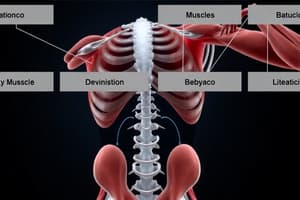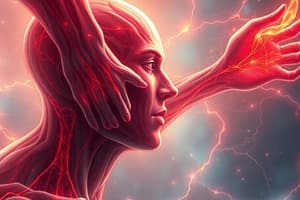Podcast
Questions and Answers
What characteristic distinguishes voluntary muscles from involuntary muscles?
What characteristic distinguishes voluntary muscles from involuntary muscles?
- Voluntary muscles are always attached to bones.
- Voluntary muscles have a slower contraction speed.
- Voluntary muscles are found only in the heart.
- Voluntary muscles are under conscious control. (correct)
Which of the following muscles is classified as involuntary?
Which of the following muscles is classified as involuntary?
- Skeletal muscles in the leg
- Smooth muscles in the intestines (correct)
- Skeletal muscles in the arms
- Cardiac muscles in the facial area
What is a common cause of muscle strain?
What is a common cause of muscle strain?
- Excessive stretching of a muscle (correct)
- Gradual weakening of muscle fibers
- Involuntary muscle contraction
- Physical inactivity and rest
Which type of muscle is primarily responsible for pumping blood throughout the body?
Which type of muscle is primarily responsible for pumping blood throughout the body?
Which injury results from the muscle contracting involuntarily and painfully?
Which injury results from the muscle contracting involuntarily and painfully?
Flashcards
Voluntary Muscles
Voluntary Muscles
Muscles that are consciously controlled by your brain.
Involuntary Muscles
Involuntary Muscles
Muscles that move automatically without conscious control.
Smooth Muscles
Smooth Muscles
Smooth muscles found in internal organs, they don't have striations.
Cardiac Muscle
Cardiac Muscle
Signup and view all the flashcards
Muscle Cramp
Muscle Cramp
Signup and view all the flashcards
Study Notes
Muscle Types
- Voluntary muscles:
- Can be controlled by conscious effort.
- Examples: muscles in arms, legs, back, chest, and face.
- Involuntary muscles:
- Cannot be controlled consciously.
- Examples: smooth muscles in internal organs like the stomach and intestines, and cardiac muscles in the heart.
- Three Types of Muscles:
- Skeletal Muscles:
- Voluntary
- Attached to bones.
- Smooth Muscles:
- Involuntary
- Found in the walls of internal organs.
- Involved in continuous movement not controlled consciously.
- Cardiac Muscles:
- Involuntary.
- Found primarily in the heart walls.
- Responsible for pumping blood throughout the body.
- Skeletal Muscles:
Muscle Disorders and Injuries
- Strain:
- Occurs when a muscle is stretched excessively, causing tears.
- Also known as a pulled muscle.
- Painful injury caused by accidents, overuse, or improper muscle use.
- Muscle cramp:
- Involuntary and painful muscle contraction that doesn't relax.
- Muscle bruise:
- Results from a muscle impact with a hard object.
Studying That Suits You
Use AI to generate personalized quizzes and flashcards to suit your learning preferences.



